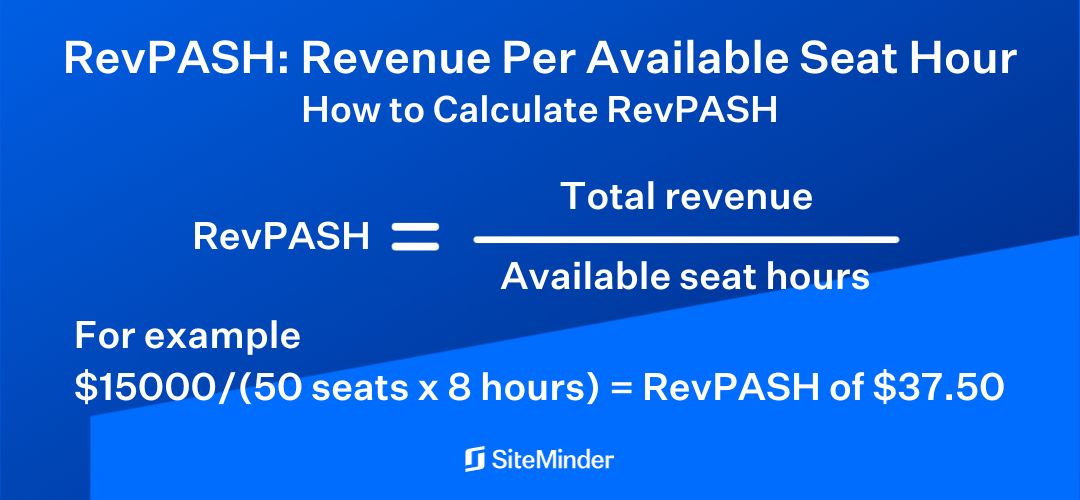What is RevPASH?
RevPASH means revenue per available seat hour and applies if your hotel has a restaurant or other food and beverage outlets. RevPASH also occurs outside of the hospitality industry, such as at hairdressers where appointments on weekends are more expensive because there are less slots available.
It was introduced in 1998 and can be calculated hourly, weekly, or monthly.
Tracking the RevPASH metric is important for understanding the usage and revenue of a ‘seat’ and allows you to better plan your food and beverage operations.
While you might be more accustomed to tracking metrics like RevPAR, ADR, or TrevPAR at your hotel, RevPASH is also an incredibly important metric to measure, especially if you have any kind of restaurant, theatre, or similar outlet in your property where guests gather and spend revenue.
So, let’s explore what RevPASH means for your business.
Table of contents
What is the use of RevPASH in hotels?
In the context of hotels, especially those with dining facilities, RevPASH helps in determining how well the available seating space in a restaurant or dining area is being used to generate revenue. The higher the RevPASH, the better the performance.
Unlock your hotel’s revenue potential with SiteMinder Don't let your seats go wasted; make every booking count with actionable insights and strategies.
How to calculate RevPASH
To calculate RevPASH you need to divide total outlet (e.g restaurant) revenue by the available seats multiplied by opening hours.
The formula for calculating your RevPASH is as follows:
RevPASH = Total revenue / available seat hours
Total Revenue means the total sales generated during a specific period. It could revenue from food, beverages, and other services offered by the restaurant.
Available Seat Hours is the total number of seats available in the restaurant multiplied by the number of hours the restaurant is open for service. It reflects the potential capacity for generating revenue.
For example: $15000/(50 seats x 8 hours) = RevPASH of $37.50.
Once you know how to calculate RevPASH you can start thinking through how you can enhance the revenue of your hotel restaurant. Is it a matter of staying open for longer, getting more customers in at the peak of the day, or running promotions?

What does a high RevPASH mean?
A high RevPASH in a hotel indicates optimal and efficient utilisation of the available seating space within the hotel’s dining facilities to generate revenue. What does that actually mean though? Here’s a breakdown:
- Optimal space utilisation – A high RevPASH means that the hotel is effectively using its dining spaces. Whether it’s the main restaurant, a café, or a rooftop bar, the seats are frequently occupied, and the turnover rate is high. This suggests that guests are consistently choosing to dine in the hotel’s facilities, and the seating arrangements are accommodating a good number of patrons throughout operational hours.
- Increased revenue generation – A primary objective of monitoring RevPASH is to gauge revenue generation. A high value indicates that the hotel’s dining facilities are not just attracting guests but are also successfully translating those visits into significant revenue. This could be due to a combination of factors such as competitive pricing, quality of food and service, or unique dining experiences offered.
- Operational efficiency – A high RevPASH can also hint at efficient operations. It suggests that the hotel is effectively managing its resources, including staff scheduling, inventory management, and promotional activities, to ensure that the dining areas are busy and profitable during open hours.
- Guest satisfaction – While RevPASH is primarily a financial metric, a consistently high value can indirectly indicate guest satisfaction. If guests are choosing to dine frequently at the hotel’s facilities and are spending more, it’s a good sign that they are enjoying the dining experience, which can encompass food quality, ambiance, service, and overall value for money.
A high RevPASH in the hotel context is a positive indicator of both financial success and operational effectiveness for the hotel’s dining facilities. It suggests that the hotel is not only attracting guests to its dining areas but is also providing an experience that encourages them to spend, thereby maximising revenue from available seating space.
Optimise your pricing and maximise room revenue
SiteMinder connects with leading revenue management systems to automatically update your optimised rates across all distribution channels in real-time, maximizing the yield of every room through intelligent pricing.
Learn More
What does a low RevPASH mean?
As you can imagine, a low RevPASH is an indicator that something isn’t going well for the hotel’s dining areas, either due to internal operational issues or external challenges. A low RevPASH could indicate:
- Underutilisation of space – A low RevPASH suggests that the hotel’s dining spaces are not being used to their full potential. The seats might remain unoccupied for longer durations, leading to wasted space and missed revenue opportunities.
- Reduced revenue generation – A primary concern with a low RevPASH is that the hotel’s dining facilities are not generating the expected revenue. This could be due to various reasons, such as uncompetitive pricing, lack of promotions, or an unappealing menu.
- Operational challenges – Operational inefficiencies might be contributing to the low RevPASH. This could include mismanagement of inventory, leading to frequent out-of-stock situations, or poor staff scheduling, resulting in either overstaffing during slow periods or understaffing during peak times.
- Guest dissatisfaction – A consistently low RevPASH can be an indirect indicator of guest dissatisfaction. If guests are choosing not to dine within the hotel’s facilities or are spending less when they do, it might suggest issues with the quality of food, service, ambience, or perceived value for money.
- External competition – The hotel might be facing stiff competition from nearby restaurants or eateries, drawing guests away from the hotel’s dining options. This can be particularly challenging in areas with a vibrant dining scene.
- Lack of marketing and promotions – The hotel might not be effectively marketing its dining facilities or offering promotions to attract guests. A lack of visibility or awareness among guests can lead to reduced footfall and spending.
- Seasonal or external factors – Sometimes, external factors, such as off-peak seasons, local events, or even economic downturns, can impact the dining habits of guests, leading to a temporary dip in RevPASH.
Why should you use the RevPASH formula at your hotel?
RevPASH is a great metric to track daily if you have a hotel restaurant. It will let you see the impact of any adjustments you make to your revenue management strategy, and identify any challenges you need to address.
For example, if you notice that guests are coming to eat at your restaurant in small parties of two or three, you could consider changing your layout to include more small tables, allowing more total guests to dine on average.
Or you could attract more diners with meal discounts but raise the prices on your drinks. Keeping an eye on the menu of your closest competitors is also a good idea to see how you can outdo them with your own.
Whatever tactics you try, they have no value if you aren’t measuring their success with RevPASH.

